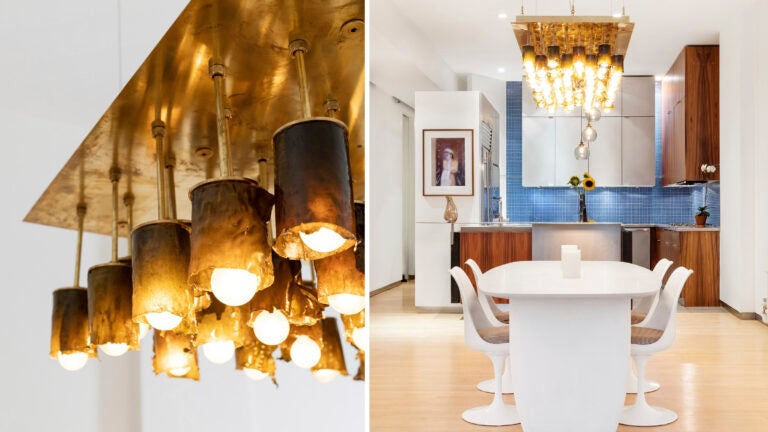
At first glance, Nina Edwards sconces and wall sconces look like rolls of antique parchment or caramel wrapped around LED lights.
Approach or just ask a New York-based designer/architect, and you'll find out they're actually made of seaweed.
The idea came to him while he was working on a doctoral research project in materials and lighting at the Oslo School of Architecture and Design, and he has now created a collection of fireplaces, lamps and chandeliers called "Chlorophyta".
Anker decided not to hide dried seaweed - their shades have all the natural stains and transparent colors of honey.
"From the beginning, we wanted to preserve the integrity of the material and show its unique properties," says Anker.
She is one of many designers who think beyond traditional materials, but look for ways to produce eco-friendly designs and combine manufacturing methods.
Anker and his NA Studio team are also experimenting with other natural materials.
"For lighting, we used red/orange algae, durable feathers, horseshoe crab shells and crushed seashells, as well as corn rubber," he says. There are organic furniture materials: lentils, buckwheat and other fillers for upholstered furniture, as well as natural wicker, cork, bamboo.
Great progress has been made in converting recycled plastic bottles, wood and plant fibers into materials that can be used in the home and fashion industries to reduce the negative environmental impact of cotton production, plastic pollution, etc.
Hemtextile opens this week in Frankfurt, Germany, showcasing the latest in international textile design and development.
Olaf Schmidt, vice president of textiles and textile technology at Heimtextil, says: "We see how companies can recycle inorganic materials such as nylon, plastic and metal, such as carpet tiles that break down at the end of life, and use them as raw materials for new tiles ".
Others recycle organic materials such as linen and raffia.
"And there are algae that are used to make acoustic carpets that provide good insulation, fire resistance and moisture control," Schmidt said. "At the end of their useful life, the panels can be cut and reused."
At last summer's fair, innovative materials included cork and fibers from recycled PET (plastic) bottles.
"Cork is breathable, hypoallergenic, antibacterial, insulating and durable," Schmidt said.
Bush home decor products include trays, tables, wall panels and fixtures. For example, you can buy Portuguese cork paper rolls on Etsy.com.
Cork is also ground and applied to fabric to create soft vegan leather, which some designers use to upholster chairs and sofas, while others turn it into jackets, trousers, hats, bags and umbrellas. For example, "Svala" produces cans, bags and handbags from material made from cork.
"The biggest trend is sustainability," says fashion industry analyst Veronika Lipar. "The industry is trying to reduce its impact on the environment and avoid more pollution."
Patagonia, North Face and Timberland are among the companies that now use natural materials from renewable sources.
Canadian shoemaker Native Shoes Schmidt turns recycled PET bottles into a synthetic yarn called Hydroknit, which the company calls "knit bone" for lightweight shoes and boots.
Italian brand Campos offers quick-drying swimsuits and trunks made from PET bottles.
The yarn itself is sold by the skein at a specialty yarn store, Etsy. Lightweight, stretchy and strong, it can be crocheted, sewn and woven into items such as backpacks or textiles.
Among other works:
♻The Italian company Frumat has developed vegetable leather from apple production waste.
♻Two Mexican inventors, Adrián López Velarde and Marte Cazares, created a skin called "Desert" using cactus leaves. Because cacti tolerate drought, heat and poor soil well, they attract the attention of developers of new materials.
♻Pinatex helps Philippine farming communities use pineapple harvest waste to create materials that can be sold to shoe, accessory and clothing manufacturers.
♻ California-based company Bolt Thread created Mylon, a mycelium-based leather used by brands such as Adidas, Lululemon and Stella McCartney.
♻ Finally, some house glass walls in cars came to life. Companies break up discarded windshields and then boil the mixture. Powdered mud is a hard opalescent material called fritted glass.
"Clear glass is now one of the four main mosaic lines. There is an impressive range of colors and great durability," says Ted Acworth, founder of Boston-based tile manufacturer Artic.
Cambridge designer Annie Hall used a mix of clementine, sky and blue glass in a recent kitchen backsplash project.
“I always hope to find products made from environmentally friendly resources for my design projects, and I'm glad etched glass is just that,” he said.
address log
Get the latest news on buying, selling, renting, home design and more.


Post a Comment
Post a Comment